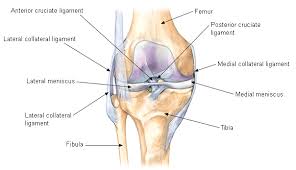The medial collateral ligament (MCL) and the lateral collateral ligament (LCL) are external ligaments of the knee that support the joint as forces directed medially and laterally are applied respectively. The MCL is situated on the inner side of the knee and is a broad ligament spanning from the femur to the tibia. Deeper fibres of the MCL attach to the joint capsule and the medial meniscus. The function of the MCL is to stabilise the knee as valgus force (pressure to the outside of the knee) is applied. The LCL is located on the outer side of the knee and is thinner compared to the MCL. The LCL spans from the outer side of the femur to the head of the fibular and stabilises the knee preventing lateral opening of the knee joint as varus force is applied.
The MCL is commonly injured when an excessive valgus force is placed on the knee often with the knee slightly bent. Injury to the LCL is less common and occurs when a strong varus force is applied to the knee. The severity of ligament damage is classified as either grade 1 (mild), grade II or grade III (complete rupture).
Diagnosis of either an MCL or LCL injury is based on the mechanism of injury and physical testing. Grade I injuries typically present with tenderness over the ligament, minimal swelling and pain but minimal laxity with ligament stress testing. Grade II injuries are partial tears which result in laxity on physical testing, swelling and problems bending the knee. Grade III injuries are complete ruptures of the ligament resulting in more severe swelling and gross laxity of the knee. Grade III injuries can be associated with additional injuries to other structures of the knee. Low grade MCL/LCL injuries do not typically require scans however an MRI may be requested if grade III ligament damage in conjunction with other injuries is suspected.
The duration of rehabilitation depends on the severity of injury. Grade I injuries generally require 3-6 weeks rehabilitation, Grade II 8-12 weeks and Grade III longer depending if surgery is performed. Grade I & II injuries are typically treated conservatively with bracing or taping utilised to support the ligament. Progressive range of movement and strengthening exercises are performed prior to returning to sport. Grade III injuries may require surgery followed by wearing a hinge knee brace for 3-6 weeks. Rehabilitation for Grade III injuries follows a similar path to lower grade injuries, however over a longer duration. Rehabilitation focuses on knee strength and range of movement, agility, power and sport specific activities.

